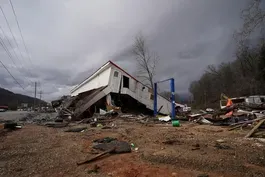
Looking back at Mount St. Helens’ eruption 45 years later
Clip: 5/18/2025 | 4m 33sVideo has Closed Captions
What scientists have learned from Mount St. Helens’ devastating eruption, 45 years later
It was 45 years ago today when Mount St. Helens erupted, triggering the biggest landslide in Earth’s recorded history and creating an ash cloud that reached across the country. John Yang looks back at the deadliest and most destructive volcanic eruption in U.S. history with Steve Olson, author of “Eruption: The Untold Story of Mount St. Helens.”
Problems with Closed Captions? Closed Captioning Feedback
Problems with Closed Captions? Closed Captioning Feedback
Major corporate funding for the PBS News Hour is provided by BDO, BNSF, Consumer Cellular, American Cruise Lines, and Raymond James. Funding for the PBS NewsHour Weekend is provided by...

Looking back at Mount St. Helens’ eruption 45 years later
Clip: 5/18/2025 | 4m 33sVideo has Closed Captions
It was 45 years ago today when Mount St. Helens erupted, triggering the biggest landslide in Earth’s recorded history and creating an ash cloud that reached across the country. John Yang looks back at the deadliest and most destructive volcanic eruption in U.S. history with Steve Olson, author of “Eruption: The Untold Story of Mount St. Helens.”
Problems with Closed Captions? Closed Captioning Feedback
How to Watch PBS News Hour
PBS News Hour is available to stream on pbs.org and the free PBS App, available on iPhone, Apple TV, Android TV, Android smartphones, Amazon Fire TV, Amazon Fire Tablet, Roku, Samsung Smart TV, and Vizio.
Providing Support for PBS.org
Learn Moreabout PBS online sponsorshipJOHN YANG: It was 45 years ago today that Mount St. Helens, a volcano 50 miles north of Portland, Oregon exploded in a spectacular and devastating eruption.
It triggered the biggest landslide in Earth's recorded history.
200 square miles of forest was flattened.
The ash cloud eventually reached the northeastern United States.
57 people died, making it the deadliest and most destructive volcanic eruption in US history.
Steve Olson is the author of "Eruption: The Untold Story of Mount St.
Helens."
Steve, remind us, take us back just how big, how devastating was this explosion, this eruption?
STEVE OLSON, Author, "Eruption: The Untold Story of Mount St.
Helens.
": Oh, it was an incredible event.
It was the largest natural disaster in U.S. history.
The eruption of Mount St. Helens was much more powerful than any hurricane, any explosion of a nuclear weapon, any.
It was, it was a devastating event for southwest Washington state 44 years ago.
JOHN YANG: But are effects still being felt in certain parts of the region?
STEVE OLSON: They are actually communities downstream from Mount St. Helens are still dealing with sediment that washed down in the eruption that keeps coming down the rivers and clogs water intake pipes and fills up the rivers, making it hard for boats to get through.
The eruption generated so much sediment that scientists don't actually know what to do with it.
They've erected a dam to try to control it, but no, it's going to be an ongoing problem for decades, I'm sure.
And that's even assuming the volcano doesn't erupt again.
JOHN YANG: Now, most people think of a volcanic eruption as going up the mountain, sort of blows the top off, but I understand this went sideways, lateral, is that right?
STEVE OLSON: It did.
And that was one of the reason that the danger zones around the mountain were so close to the volcano.
Of the 57 people who died, 54 were outside the danger zones.
And the three who were inside the danger zones actually had permission to be in that area.
Before 1980, volcanologists didn't have a lot of experience with volcanoes that collapse.
But since Mount St. Helens, because of all the lessons that they learned from that eruption, they've actually identified hundreds of volcanoes all over the world, some on other planets, that have done just that.
They have collapsed and then rebuilt themselves back up and then collapsed again.
JOHN YANG: So is Mount St. Helens sort of given scientists a place to study this, a place to study these kinds of eruptions?
STEVE OLSON: It has been.
No, it's probably been the most important volcanic eruption in the history of the study of volcanoes.
There were a lot of people around the volcano who were taking pictures of it.
Some of them did not survive, but a lot of people survived with their photographs.
And those photographs just provided incredible documentary evidence of the eruption and its aftermath.
JOHN YANG: As I understand, the U.S. Geological Survey said that before 1980, the last eruption was, I believe, 1857.
But there were warning signs, weren't there that some rumbling starting in March.
And has this taught anything to scientists or emergency preparedness people that's been used over the years?
STEVE OLSON: There were warnings and that was a warning that magma was moving around underneath the volcano.
So, scientists started monitoring the volcano using the technologies that they had available at the time and trying to figure out what the volcano was going to do.
Since then, technologies have been developed that allow much more accurate and careful monitoring of volcanoes.
There are many more seismometers that are around volcanoes.
You can use GPS or radar to measure the movement of the ground so that you know that magma is moving around in there.
You can measure volcanic gases.
And so volcanoes are much more closely monitored now than they were in 1980.
But nevertheless, yes, in the two months before the big eruption of Mount St. Helens, lots of volcanologists came to that area.
And we're keeping a close eye on the volcano.
JOHN YANG: There were lots of people, lots of communities who either lived through it or lost family members in this.
What's the legacy for them of Mount St. Helens?
STEVE OLSON: Lots of people in southwest Washington and elsewhere lost family members that day.
And so for them, this anniversary is sort of a day of remembrance.
But it's also a day where a lot of people in Washington state and elsewhere are reminded how lucky they are that they were killed by the volcano.
It happened on a Sunday morning, and there were probably fewer people around the volcano right at that point than at any other time during the week.
If the volcano had erupted just 24 hours later, hundreds of loggers who were cutting down the old growth right around Mount St. Helens would have been killed.
It would have been the greatest natural disaster and industrial disaster in U.S. history.
JOHN YANG: Writer Steve Olson, thank you very much.
STEVE OLSON: My pleasure.
Consumer confidence hits near-record low amid trade worries
Video has Closed Captions
Clip: 5/18/2025 | 5m 54s | Consumer confidence hits near-record low amid worries over Trump trade policy (5m 54s)
News Wrap: Biden diagnosed with prostate cancer
Video has Closed Captions
Clip: 5/18/2025 | 3m 11s | News Wrap: Biden diagnosed with prostate cancer, reviewing treatment options (3m 11s)
Scientists working on flagship climate report dismissed
Video has Closed Captions
Clip: 5/18/2025 | 5m 31s | What the dismissal of hundreds of scientists means for a flagship climate report (5m 31s)
What to know about the new federal law against revenge porn
Video has Closed Captions
Clip: 5/18/2025 | 4m 43s | What to know about the new federal law against revenge porn and explicit deepfakes (4m 43s)
Providing Support for PBS.org
Learn Moreabout PBS online sponsorshipSupport for PBS provided by:
Major corporate funding for the PBS News Hour is provided by BDO, BNSF, Consumer Cellular, American Cruise Lines, and Raymond James. Funding for the PBS NewsHour Weekend is provided by...















